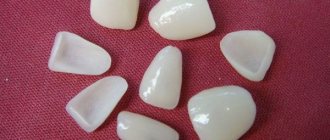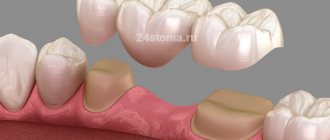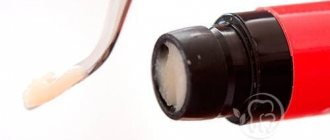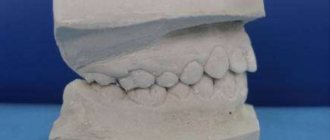2956
The use of cobalt-chromium alloy is widely used in the practice of orthopedic dentists. The resulting metal products are reliable, durable and relatively safe for the patient’s health.
Structures made of hard alloys are used for the manufacture of both single crowns and bridges.
General overview
The alloy of cobalt and chromium has a wide range of applications. It is used for the manufacture of crowns, bridges and clasp systems. In implantology it is used in the production of abutments.
Recently, this type of alloy has been used less frequently, as the latest developments have made it possible to produce more durable materials.
Cobalt-chrome crowns are installed in the following cases:
- if there is a need to restore the crown part of a tooth with significant destruction;
- when pathological abrasion of the surface enamel occurs;
- in case of severe manifestation of fluorosis;
- if chips or cracks appear as a result of injury;
- with an abnormal tooth shape.
Prosthetics with the installation of a bridge connection (from high-alloy steel) occurs according to the following indicators:
- if partial adentia leads to the loss of several teeth standing in a row in a row;
- in case of expiration of the service life of the bridge (planned replacement);
- lack of alternative to another type of prosthetics.
Installation of orthopedic structures using cobalt and chromium is not carried out in the following situations:
- when the patient has an allergic reaction to the alloy components;
- if periodontal disease has led to the loosening of dental units that are supposed to be used as supporting ones;
- low coronal part;
- advanced forms of abnormal bite, and impaired functionality of the mandibular joint;
- dental diseases in the acute phase (gingivitis, stomatitis).
Reasons for the development of a cyst under the tooth crown and treatment of pathology in modern dentistry.
Come here to find out the purpose of tooth depulpation before prosthetics.
At this address https://www.vash-dentist.ru/protezirovanie/nesemnyie-p/koronki-np/kombinirovannuyu-luchshe-vyibrat.html we will consider the positive properties of a cast combined crown.
What is made from CHS
The following are made from CHS:
1. Crowns.
2.Bridges.
3. Prostheses.
4. Implants.
Let's look at each product separately.
Crowns
Crowns are cap-shaped microprostheses that completely or partially cover the coronal part of the tooth. They are used for defects that cannot be eliminated with onlays, inlays or fillings . That is, when the degree of destruction exceeds 50–80% of the crown part of the tooth.
A KHS crown can consist of one metal or be a metal frame coated with ceramics, plastic or powder coating.
Metal-ceramic crowns (KHS, bioalloy)
Metal-ceramics is one of the types of dental prosthetics that can solve many problems associated with the restoration of damaged and lost teeth. Thanks to the metal base, this type of tooth reconstruction is very durable and allows you to restore chewing function in full. The reliability of the design ensures long-term use. Ceramics, in turn, allows you to achieve a natural look and recreate the natural shape and color of the tooth. Metal ceramics are made individually and follow the contours of the dentition. The appearance of the metal-ceramic crown is maintained throughout the entire period of operation.
Solid crowns (KHS)
A solid crown is a metal crown that is made from a cobalt-chromium alloy using the modern solid casting method. This method assumes that the entire structure is cast simultaneously. In the case of making bridges, this completely eliminates the need to solder crowns to each other.
Bridge prostheses (BDP)
Bridges are installed when there is a defect of no more than three teeth in the chewing area or 4 in the frontal area. As a rule, the MVP frame made of cobalt-chromium alloy is made by casting. This ensures the accuracy of the design.
The advantages of such prostheses include high strength, rare cases of individual intolerance (compared, for example, with nickel-chrome frames), and cost-effectiveness.
The main disadvantage of bridges is the need to grind the teeth (reducing their service life), and overloading the supporting units, which sometimes leads to the destruction of their periodontium.
Removable clasp dentures
Cobalt-chrome is considered the best material for making the frame of arched prostheses, due to its strength, compactness, durability and cost-effectiveness. The structure is made by casting.
Superstructures for implants
The orthopedic part of intraosseous implants, made of cobalt-chrome and lined with ceramics, provides a clinical effect comparable to gold alloys.
Overview of materials
Orthopedic structures made of high-alloy steel have been used since 1933. They contain the following components:
- Cobalt. The percentage of this component ranges from 66 to 67%. Its presence provides the main mechanical properties of the product.
- Chromium. Its percentage should not be less than 30%. The presence of this component ensures the hardness and strength of the structure, and also increases the material’s resistance to corrosion and oxidation.
- Nickel. Its content in the alloy does not exceed 5%. It ensures the malleability and ductility of the material.
- Molybdenum. A small concentration (up to 5%) gives the material a fine grain structure, which makes dental products durable.
- Manganese. Simultaneously performs several tasks - improves the characteristics of the finished product and increases its strength; the quality of casting improves; The melting point decreases, which ensures comfortable production and subsequent processing.
- Carbon. An additional element that gives the alloy fluidity properties and reduces the melting point.
In addition to the above materials, nitrogen and silicon can sometimes be added to the high-alloy steel composition. In this case, the content of the first element should not exceed 0.1%, and the second 1%. Otherwise, the products will lose their plasticity and their fragility increases.
It is important to note! Abroad (USA), beryllium and gallium are added to the cobalt-chromium alloy. In Russia, such components are not used due to their toxicity and ability to accumulate in the body.
METAL ALLOYS IN MODERN DENTISTRY Nickel-chromium alloys for metal ceramics
Lev Garamov, dental technician, consultant, Moscow
The quality of the prosthesis directly depends on the casting of its frame, so it is necessary to choose a material with the most suitable properties. The professional requirements of dental technicians for dental alloys are constantly increasing. Precise marginal fit of the cervical edge of the crown to the cervical edge of the stump, absence of shrinkage and balance, absence of grain and pores on the surface of the product, bright metal luster on the “open” occlusal surface after polishing, ease of processing of the alloy and its compatibility with the widest range of ceramic materials and much more.
The modern dental market is overflowing with alloys. However, it is necessary to determine the individual characteristic features inherent in a particular product, which give it “originality” in certain aspects of differences, physical and chemical properties, and, importantly, the price/quality ratio. In this context, I want to share my personal experience of working with the non-precious alloy for metal-ceramic and solid-cast bridges “WEST 2000” made in the USA, with which I have been successfully working for several years. I will try to reveal the properties and advantages of this alloy. Physicochemical and technological properties of the alloy “WEST 2000” Let's start with the fact that, first of all, the individuality of the alloy lies in the properties of its constituent elements. This alloy is formed by the following main elements: nickel (up to 72%), chromium (12%), molybdenum (9%); In addition, “WEST 2000” includes two additional elements: cobalt (3%), titanium (2%). Let's consider the listed elements individually. Nickel (Ni) is a silvery-white metal with good toughness and malleability. This metal is resistant to oxidation when in contact with air and water, and is also resistant to alkalis. Nickel additives increase the mechanical properties of alloys, their toughness, reduce the degree of shrinkage and give chemical stability to the compounds. If the alloy contains 60–80% nickel and 20–40% chromium, then this alloy is nickel-chromium . Chromium (Cr) is a white metal with a slight bluish tint and has high corrosion resistance . Chromium molecules dissolve in hydrochloric acid. At high temperatures, it reacts with oxygen and transforms into chromium oxide (Cr2O3). Chromium oxide is used in the manufacture of polishing pastes used to polish the metal surface of dentures. When interacting with oxygen, this element also forms chromic anhydride (CrO3). Chromium has increased brittleness, as a result of which the percentage of this element in the composition of alloys should not exceed the established norm. The presence of chromium in the alloy in a certain percentage is necessary to prevent corrosion of its elements. Chromium oxide is used in the manufacture of polishing pastes used to polish the metal surface of dentures. Molybdenum (Mo) is a refractory metal with a light gray tint. Resistant to corrosion in cold solutions of hydrochloric and sulfuric acid, as well as to alkalis. Dissolves in nitric acid. The presence of this element in the alloy composition helps to improve its intergranular structure. Cobalt (Co) is a silvery metal with a reddish tint. Does not oxidize under the influence of air and water, slightly soluble in solutions of organic acids. It has a high degree of hardness, as a result of which it increases the mechanical properties (strength) of the alloy. Titanium (Ti) is a silver-white metal with high strength and corrosion resistance when in contact with atmospheric air and water. A thin, durable oxide film forms on the surface of titanium, which prevents its oxidation. This element is resistant to nitric acid and slightly soluble in sulfuric acid. Forming a link in the chain of connecting elements of the alloy, titanium in a small percentage helps to reduce chromium carbides in the alloy and thereby increases the strength of the alloy. Despite the fact that titanium is a component of this alloy, the casting process is carried out on standard foundry installations. Titanium is a bioinert metal (this element is non-toxic), as a result of which it is widely used in implantology.
Physical and mechanical properties of the alloy: Vickers hardness: 220 (hv) Elongation: 10–12% Specific gravity: 7.9 (g/cm) Yield strength: 75,000 PSI Elastic modulus: 23,000 KTE 12.7–14.1 Point melting point: 1,315°C (2,400 F) Fig. 1 a, b. Applying “Distanz-varnish” to the surface of the prepared areas of plaster dies.
Modeling a wax composition Below is a list of errors that can affect the quality of the metal frame made during modeling. Rice. 1 (a, b). Do not make mistakes at the stage of coating the dies with “Distanz (stumpf) varnish”. In the area of the cervical ledge, is prohibited to avoid the formation of gaps between the cervical edge of the crown and the cervical edge of the stump. Do not use Distanz-varnish to seal the plaster surface from wax. Distanz-varnish is intended only to imitate a cement layer and is not a surface insulator. To isolate the surface of the plaster stump from wax, insulating liquids are used (for example, “Pro-Art” / IVOCLAR).
| Rice. 2. Exact marginal fit of the crowns and the marginal edge of the inlay to the boundaries of the preparation. |
Areas of surfaces not covered with Distanz varnish must be treated with a means for “hardening” the exposed gypsum surface (for example, Hartebad, Renfert) and only then apply an insulating liquid to prevent the insulating agent from being absorbed into the plaster. Conversely, in those areas where the application of Distanz varnish is required, it is not recommended to treat the surface with a gypsum hardening agent, as this may lead to separation of the Distanz varnish from the surface of the stump, due to a change in the structure of the gypsum surface. Many specialists are trying to learn how to control the thickness of the applied layers of “Distanz-varnish” and even try to control it using measuring instruments. I dare to assure you that this is unnecessary. The crown is fixed on the ledge, and the thickness of the varnish of 2-3 microns makes absolutely no difference. In this case, the marginal fit of the crown to the cervical edge of the ledge is more important. This is one of the important factors that can negatively affect the quality of a metal-ceramic prosthesis. When refining the cervical edge of the crown with cervical wax, you should not use soft wax. Choose “plastic” cervical wax for work (for example, “Thowax”/Yeti-dental or “Pro-Art”/IVOCLAR)
| Rice. 3. View of the finished wax composition of the frame and inlays (inlay/onlay). |
(Fig. 2), to avoid deformation of the wax composition of the crown when scraping with a cutting tool. View of the wax composition of the bridge (Fig. 3a) and inlays (inlay/onlay), displaying the relief of the anatomical shape of the chewing surface (3.b). In order to avoid the occurrence of defects during the casting process, as well as at the stages of lining the bridge with ceramics (cracks/chips), the established limit should not be exceeded: the minimum thickness of the metal frame before processing is 0.35–0.4 mm. Installation of sprue channels and compensation beam Length of sprues 2.5 mm, diameter 3.5 mm. On the chewing surface of the wax inlay structure (inlay/onlay), the sprue channels are installed palatally, at an angle of 45 degrees (Fig. 4a).
| Rice. 4. Installation of gating channels. |
On the surface of the wax composition of the frontal bridge, the sprue channels are installed vestibularly, at an angle of 45 degrees (Fig. 4b). The sprue channels on the front section can be positioned vertically in relation to the object, in contrast to the side sections of the wax structure, which require a strict tilt at an angle of 45 degrees. When installing gates, it is necessary to ensure a “smooth transition of the channels into the object” (with no sharp edges at the transition boundaries) to ensure smooth penetration of the molten metal into the injection mold. The transverse compensation beam, parallel to the object, has a diameter of 5 mm. The length of the compensation beam should exceed the length of the object by 2–3 mm. When casting single crowns, no compensation beam is required. If there is a “volumetric” intermediate part of the bridge, it is recommended to install a “sprue with a depot ball” instead of the standard sprue channel. This need is explained by the following: the “voluminous, thick parts” of the bridge cool down more slowly and also retain “warmth” longer than its thin parts. It follows from this that the “thinner, cooled parts” of the frame take heat from the “thick” ones and there is a risk of deformation of the object. When installing a sprue channel with a depot ball, the occurrence of this negative phenomenon is eliminated, since it retains the “warmth” of the object. Correct placement of wax objects in the muffle ring
| Rice. 5. Installation of structures in the muffle ring. |
The wax objects are placed in the muffle at an angle of 45 degrees. closer to the wall of the muffle ring, as a result of which the object is located outside the thermal center zone (Fig. 5). This order is due to the following. During casting, the molten alloy, due to gravity, flows into the muffle ring and fills the gate channels, then the entire empty muffle space. The poured metal, in the hollow zones of the muffle space, located away from the thermal center, solidifies faster and draws liquid alloy from the reservoir of the gating channels. It is for this reason that when installing a wax composition in a muffle it is necessary to “isolate” the structures from the hottest point. Investment process In this case, high-speed investment material “CASTORIT ALL SPEED” (DENTAURUM) was used, mixed in a percentage ratio of 80:20 (liquid: water). You can control the coefficient of expansion and shrinkage of the investment material yourself while mixing the liquid with water. The more water in the mixture as a percentage, the higher the degree of shrinkage and vice versa. The investment mass is poured from a height of 20–30 cm in a thin stream.
| Rice. 6. The required amount of alloy for casting. The amount of metal is calculated using the formula: (weight of the wax structure) x (density of the alloy). |
To avoid the formation of pores on the inner surface of the crowns, fill the internal parts of the object (especially thin ones) with investment material using a thin tool (probe). When pouring investment material into the muffle ring container, do not subject the muffle to strong vibration. The hardening time of “Castorit All Speed” is 20 minutes. After the investment has set, remove (scrape off) a thin surface layer of molding material from the side surface of the top of the muffle ring to create a porous surface for gases to escape. Many specialists, when modeling the wax composition of the frame, install “air vents” (gas outlets) in the garland area to release the compression air formed in the muffle space. However, this method should not be used because the compressed air under pressure goes in the wrong direction. After the investment has hardened, place the muffle ring in the muffle furnace at a starting temperature of 315 °C. Final temperature 845–871 °C with one hour exposure. Simmering time – 45 minutes. Due to the fact that in this case, the high-speed molding compound “CASTORIT ALL SPEED” was used during the packaging process, the muffle ring was installed in an oven at a temperature of – 950 °C. Casting Process In general, all stages of the WEST 2000 are standard, however, there are “certain subtleties” that should be taken into account, and which I tried to list in this article. The casting process of this alloy was carried out in an induction casting installation. Place the workpiece in the container of a preheated crucible, install the crucible in the foundry installation. In this case, it is necessary to place the alloy blanks in the crucible in such a way that the process of melting the “metal pellets” by the furnace inductor proceeds simultaneously. The melting point of the alloy is 1,315°C (2400 F).
| Rice. 7a, b. Casting process. |
ATTENTION: When melting the “WEST 2000” alloy, do not wait until a “puddle of metal” forms, as this will begin to burn out the alloy alloy. As soon as the process of changing the shape of metal blanks (melting) begins to occur, immediately start the foundry installation (Fig. 7a, b). Metal melting is carried out at maximum power, according to the specified temperature. When the alloy overheats, the metal becomes contaminated with oxides and, as a result, the structure of the alloy is destroyed and its physical and mechanical properties deteriorate. A clean crucible, uncontaminated with oxides, indicates that the alloy has not overheated and the crucible can be reused (Fig. 8).
| Rice. 8. “Clean” crucible, uncontaminated with oxides. |
To avoid possible deformations, do not use a hammer when unpacking, but do it using plaster scissors and sandblasting. “Cast” structures before sandblasting (Fig. 9). The absence of an oxide film on the surface of the metal indicates the high quality of the alloy, and also eliminates the possibility of overheating during the casting process. Finished metal frame and inlays (inlay/onlay) after processing. Pay attention to the accuracy of the marginal fit of the crowns to the cervical ledge, as well as the inlay to the boundaries of the preparation (Fig. 10).
| Rice. 9. Cast structures before sandblasting. |
The metal surface after polishing has a strong shine. Metal structures are lightweight and have the necessary rigidity. This alloy is not “sticky” (unlike nickel-chromium alloys from other companies), which is observed when running a cutter along the metal surface during processing. Metal surface treatment should be carried out according to the recommendations of the alloy manufacturer (see instructions). If there are defects (pearls/burrs) on the inner surface of the frame after casting, then this factor indicates the following negative aspects that occur at the molding stage: – malfunctions of the vacuum mixer; – incorrect percentage ratio – powder/liquid/water; – the presence of “sharp edges” in the incisal area of the gypsum stump, preventing the pouring of molding material into the internal parts of the crowns, due to the lack of the required distance between the walls of the crowns.
| Rice. 10. View of the finished, processed metal frame and inlays (inlay/onlay) on the working model. |
The quality of the “WEST 2000” alloy allows you to reuse “spent” parts of the gating system (base), remaining from the moment of the initial casting, in a percentage ratio of 30x50 (used + new).
First, it is necessary to place blanks of “primary” metal in the crucible so that the “pure” alloy first fills the space of the muffle ring. When reusing metal, perform the following steps to clean the alloy: Remove sprues and flash, then sandblast with aluminum oxide. After this, you should place the metal in distilled water and clean the alloy in an ultrasonic unit for 2–4 minutes. When using “waste” metal, do not forget that the surface of its “base” must be smooth, as this indicates that the alloy has not overheated. If there are holes or pores on the surface of the “base,” this is clear evidence that the alloy has been overheated and the metal is not suitable for reuse. In conclusion, it should be emphasized that this alloy is compatible with ceramic compounds of many well-known brands - Ceramco, Duceram/Duceram Plus, Ips Classic, Exelco, Elephant, Shofu, Noritake, and many others. More detailed information about the alloy “WEST 2000” can be obtained by calling in Moscow: (095) 336-6811, 335-8069 (No. 2 (43) 2004) pp. 66-69
The process of creating structures
The process of manufacturing crowns and bridges from cobalt-chromium compounds occurs in stages in the following sequence:
- At the first appointment with the dentist, the oral cavity is examined , after which tactics for the treatment process are developed.
The material is selected and the cost of the product is announced. If necessary, additional research methods are prescribed (an X-ray or computed tomography is performed). - During the preparatory stage, the destroyed part of the crown of the tooth is restored. For this purpose, pins or stump inlays can be used.
To prevent the development of possible complications, pulp devitalization is performed. This is due to the fact that when grinding there is a risk of burns. Removal of the nerve also occurs when the visible part of the tooth is severely destroyed. - Preparation takes place for reliable fastening of the future orthopedic structure. For this purpose, burs with a diamond attachment are used.
If the manipulation occurs on “living” teeth (when the pulp is not removed), then it involves the use of local anesthesia. The thickness of the surface to be turned does not exceed 2 mm. A minimum degree of grinding is allowed if cast products are to be installed. - Impressions are made using a special silicone mass. It is applied to a special spoon and placed in the oral cavity, repeating the shape of the jaw row.
The impression is sent to the laboratory to make a model on the basis on which the orthopedic structure (bridge or crown) will be made. - After successful fitting, the finished products are fixed in the oral cavity using a cement composition.
Metal structures can be manufactured using the following techniques:
- Casting. This technology provides the best final result, due to which the structure adheres well to the tooth surface without putting increased pressure on the gum tissue.
This minimizes the chance of pathogenic microflora penetrating under the prosthesis. In addition, the technique allows you to take into account the individual characteristics of the dentition. - Punching. It is used in rare cases, since the technique is considered outdated. Products obtained in this way do not take into account the anatomical features of the patient’s oral cavity, which is why the edges of the structure do not fit tightly to the gums.
The video shows the process of welding a denture made of cobalt chromium.
Common parameters
Each alloy option for dental prostheses has its own composition; manufacturers often use their own developments and combinations.
The main thing is to bring the composition and characteristics of the substance to a certain standard and obtain a combination of certain qualities:
- safety. The metal must be absolutely safe, maintain its parameters and not emit harmful compounds during operation;
— corrosion resistance. Raw materials must resist corrosive processes, which eliminates oxidation and related problems throughout the entire guaranteed service life;
- strength. Components made from an alloy must withstand significant variable and static loads, such as compression, bending, and methodical movements in a certain direction;
- aesthetics. The use of parts should not come at the expense of appearance; first of all, it is necessary to recreate the appearance of natural units and obtain acceptable operational parameters;
- availability. This version of prostheses, although inferior to others in a number of aspects, surpasses them in the combination of price and quality. For example, the products are aesthetically comparable to zirconium dioxide, but the price tag is several times lower.
The alloy is non-toxic, but during service, especially if the processing features, recommended composition or care are not followed, they can release components that provoke reactions in the body. Because of this, the designs are considered more allergic and will require a comprehensive examination in the dentist's chair before choosing this type of denture.
The metal resists corrosion for a long time, but can cause another negative effect - a galvanic reaction. It can only be provoked by the presence of artificial components made of another metal, in particular stainless steel, in the oral cavity. Therefore, before carrying out operations, you need to make sure that no conflict will arise. Often in this case, existing elements are replaced with ones similar to those being installed.
The strength of the alloy is maintained only under strict compliance with the processing conditions, composition and recommended parameters of the implanted elements. You can get a low-quality product due to the negligence of the technician or the company producing the blanks. In the second situation, problems most often arise when purchasing blanks from untested and little-known companies. You can navigate by price; high-quality ones cannot be too cheap, but there is no point in purchasing prohibitively expensive ones.
Metal ceramics are one of the examples of the best products in terms of compliance with natural units. Components (crowns) are obtained by layer-by-layer application of a ceramic composition to the alloy surface. Due to the possibility of color adjustment, it is possible to bring products into full compliance with natural teeth, either preserved ones, or to fulfill non-standard wishes of the client.
Material forms
- Ingots weighing 7-10 g. Produced by casting in an atmosphere. Disadvantages include casting defects due to the increased gas content.
- Rods. The molten metal is sucked into metal or quartz tubes, acquiring their shape as they solidify. Subsequently it is cut into cylindrical blanks. This is the most common manufacturing method
- Discs of various diameters and thicknesses. Manufactured in induction vacuum installations. Used for the manufacture of prosthetic structures using CAD/CAM technology.
- Granules. It is obtained by pouring the alloy into a liquid.
Physical and chemical properties
The set of alloy parameters completely depends on the constituent elements.
In the case of dental cobalt chromium, these are the following components:
- base in the form of cobalt. The element must be at least 66-67 percent; it is responsible for the increased mechanical properties of the resulting metal;
- chromium is in second place, it should be at least 26-30 percent. The component is responsible for increased hardness and improved resistance to oxidative processes and corrosion;
- Nickel is the third most important, it is responsible for increasing technological parameters. At a percentage within 3-5 percent, the material becomes more malleable, ductile and viscous. Aspects make it possible to obtain a simpler substance in terms of release;
— molybdenum gives the structure a fine grain, which has a positive effect on the strength characteristics. The element can be added no more than 4-5.5 percent;
— manganese serves to solve a whole range of problems. Firstly, it increases the strength parameters of finished products. Secondly, the quality of casting increases due to the modernization of the alloy structure. Thirdly, the melting point of the substance drops noticeably, which is beneficial under production conditions and subsequent processing. Fourth, sulfur compounds, which are considered toxic to humans, are removed.
Two more components that can be found in blanks are beryllium and gallium. The problem is that the components are toxic and during operation can release a large amount of harmful substances, some of which can be accumulated by the body. The production of such products is carried out only by the USA, adding within 2% to the composition for the purpose of alloying it. You won't find such products in Europe.
These first three elements are the main ones, thanks to them the alloy matrix is formed, therefore cobalt-chromium-nickel should be at least 85%. The data is fixed by an international standard, therefore, when purchasing a workpiece of any brand, you can expect consistently high quality and similar characteristics. If components break during molding, the chromium content threshold of 30 percent is most likely exceeded, which causes the alloy to become brittle and the mechanical and casting parameters to drop.
This is interesting: Crowns on teeth - what are they: which ones are better to install and why
Another important element is carbon, however, it is not found in all products. Its positive quality is an increase in fluidity in the molten state and a decrease in the melting point.
Nitrogen and silicon have a similar effect, but they need to be added in a very small percentage:
- no more than 0.1 percent for the first;
- up to 1% for the second.
If this threshold is exceeded, plasticity will suffer.
The downside of carbon is that it can damage the ceramic layer during the release process of the prosthesis. During high-temperature firing, it can be released in the form of gas, entering the lining. Because of this, bubbles appear at the junction of metal and ceramics and the connection between the components weakens, reducing the service life and reliability of the finished oral element.
Due to these weaknesses, a number of companies, including many domestic ones, are engaged in the production of carbon-free billets.
If the composition is observed, the finished material has a mechanical viscosity twice that of gold. Metal melts at more than 1450 degrees.
Advantages and disadvantages
This type of material when used has the following advantages:
- There are no changes in its structure during the manufacturing process. Raw materials are not subject to contamination during the melting process.
- There is no loss of physico-chemical properties due to the absence of significant thermal effects. During the manufacturing process, overheating of the workpiece and tools is avoided.
- The products practically do not shrink , which eliminates the appearance of microcracks. The material is resistant to corrosion and oxidation processes.
- The alloy composition does not tarnish for a long time, and is lightweight in comparison with structures made of platinum or gold. The products are well stamped and soldered together.
- The low cost makes it possible for people with varying incomes to get prosthetics.
The disadvantages of products made of chromium and cobalt include:
- Possibility of developing galvanic syndrome. In this case, the patient has a sour taste in the mouth and discomfort when eating. These symptoms can only be eliminated by removing the prosthesis.
- Low aesthetic value. The products are not used for prosthetics of frontal incisors.
- Prolonged wear may cause a change in the color of the gingival surface (it becomes blue), which comes into contact with the installed crown or bridge.
Does the price of a metal-free crown per tooth correspond to its quality characteristics?
In this publication we will tell you which dentures for chewing teeth are the best.
Here https://www.vash-dentist.ru/protezirovanie/nesemnyie-p/koronki-np/metallicheskuyu-s-napyileniem.html you will find detailed information about metal crowns with white coating.
Nickel-chrome dental crowns
Types of chromium-nickel crowns
Chromium-nickel stainless steel is a hard alloy whose main components are nickel, chromium and iron. In modern dental practice, several varieties of this material are used:
- 1Х18Н9Т (shiny alloy used for the manufacture of blanks (sleeves) for stamped dental crowns);
- EI-95 (material used for the manufacture of cast crowns);
- "Dentan" (an alloy with a high nickel content and a reduced iron content).
- Chromium-nickel alloys are easily stamped, soldered and almost do not wear out.
Disadvantages of chromium-nickel crowns
However, such materials also have a number of significant disadvantages. These include:
- discrepancy between the color of prosthetic devices made of chromium-nickel alloy and the color of natural dental crowns;
- too much weight of finished prosthetic devices;
- high percentage of alloy shrinkage (3-5%);
- high melting point;
- increased risk of oxidation of the prosthetic device and the appearance of an unpleasant metallic taste in the mouth.
In addition, the material is a common allergen, which means that dental prosthetics using it can cause the development of hypersensitivity reactions in dental clients suffering from allergies.
Lifetime
Crowns and bridges made from an alloy of cobalt and chromium have high strength, which is why products of this class can last from 15 to 20 years.
Most experts recommend replacing the structure after 10 years. This is due to the fact that during prolonged wear, atrophic changes occur in the gum, causing it to sag, exposing the edges of the crown. This contributes to the leaching of cement and the occurrence of pain.
The following factors may affect the service life:
- private inflammatory processes of the gums and root canals reduce the life of the crown or bridge;
- if the stamping technique was used in the manufacture of the product, then such a structure is subject to rapid wear due to the small thickness of its walls;
- eating solid foods causes deformation or breakage of the structure;
- Failure to comply with hygienic care is accompanied by the penetration of bacterial pathogens under the prosthesis, which causes its premature removal.
Rules of care
After installing crowns or bridges made of high-alloy steel, daily care is carried out as for natural teeth (twice a day). The situation is different if an alloy of cobalt and chromium was used as a frame for plastic or ceramic products.
In this case, the following rules and recommendations must be observed:
- Oral care with a toothbrush and hygienic paste should be carried out twice a day. After each meal (if this is not possible), you need to use elixirs or antiseptic rinses.
- To prevent discoloration of the crown part of the tooth, you should limit your consumption of foods with coloring properties (beets, sauces, tomatoes).
- Completely exclude rough foods (nuts, crackers) from the diet.
- Visit the dentist's office once every six months for a preventive examination. If necessary, undergo a professional cleaning procedure.
Important! During the period of cleansing the oral cavity, special attention should be paid to the place where the structure comes into contact with the gums. The accumulation of food debris leads to the development of bacterial microflora, which causes inflammatory processes.
Price
Despite the fact that the alloy of cobalt and chromium has practically ceased to be used in prosthetics of frontal incisors, it is often used as a base when making prostheses made of plastic or ceramics. In this case, aesthetics in the smile area are not lost, and the products become publicly available due to their low cost.
Products made from cobalt-chromium alloy have a low cost. Pricing is influenced by the status of the clinic, the region of Russia and the qualifications of the specialist.
Products using casting technology will cost from 4,000 to 4,500 rubles. Accordingly, a bridge of 3 units can be installed for 12,000 rubles.
Stamped designs have a starting price of 1000 rubles. At the same time, the final cost may be slightly higher due to the need for procedures to prepare for prosthetics.
Stages of creating dentures and crowns
The procedure for prosthetics depends on the type of prosthesis and the chosen manufacturing technology, which may differ for the same source material (casting, stamping, milling).
Let's consider the simplest option - manufacturing a metal-ceramic crown with a cobalt-chrome base using casting and sintering of ceramic mass.
The process consists of the following clinical and laboratory steps:
- Making a diagnosis, drawing up a treatment plan (examination and interview of the patient, radiographic studies, selection of prosthesis design).
- Grinding a tooth for a crown.
- Taking an impression of the prepared tooth and its antagonists.
- Making a plaster model based on a cast.
- Wax modeling of a metal frame.
- Crown casting.
- Fitting it to the tooth, finalizing it.
- Selecting the color of ceramic cladding.
- Installation of a metal frame on a tooth model, application of ceramic mass in layers, sintering in an oven.
- Trying on a finished crown on a tooth, modification if necessary.
- Glazing, finishing.
- Fixing the crown on the tooth with cement.
In some cases, at the request of the patient, a provisional (temporary) plastic crown is made and installed while the permanent crown is being manufactured. But this is not always done.
The video shows the process of welding a denture made of cobalt chromium.
Reviews, opinions, comments
Most dental practitioners note that products made from high-alloy steel are gradually losing their relevance.
This is due to the use of higher quality materials, which make orthopedic structures not only durable, but also provide a high degree of aesthetic value.
You can share your opinions in the “Comments” section of this article.
If you find an error, please select a piece of text and press Ctrl+Enter.
Tags dentures fixed dentures
Did you like the article? stay tuned
Previous article
Basics of bite registration using Occlufast impression material
Next article
Aquasplint is an innovative method of treating and diagnosing TMJ abnormalities











